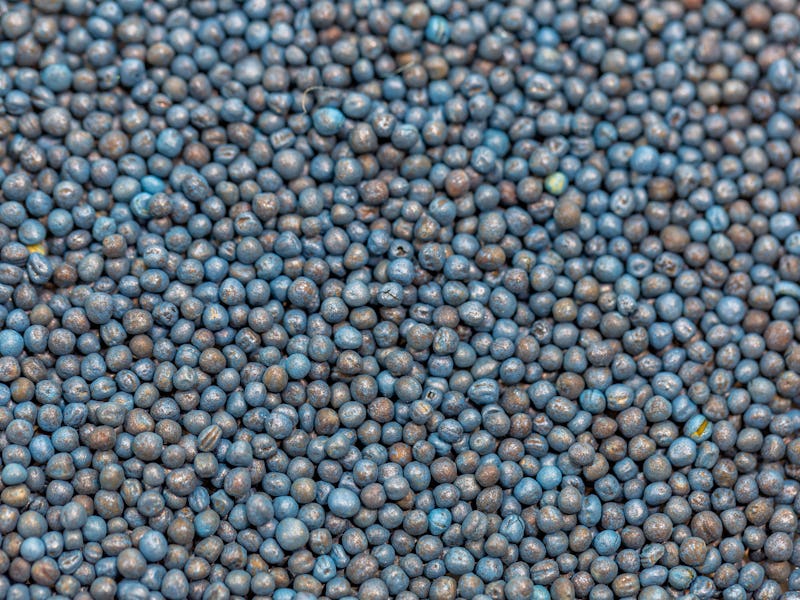Scientists accidentally created a novel method to make fertilizer more green
A new, porous material could help decarbonize ammonia production.

When strolling the aisles of your local grocery store, odds are you don’t think too much about the soil and minerals used to grow the shiny bushels of apples or bins of juicy tomatoes. But without nitrogen-rich fertilizer, the shelves would look a lot more barren.
It’s hard to overstate fertilizer’s role in the global food supply — it feeds plants a key nutrient called nitrogen to help them grow quickly and abundantly. This comes with a cost: Manufacturing enough fertilizer to feed the world takes a harsh toll on the environment.
But it’s possible to produce fertilizer more sustainably, according to a study published today in the journal Nature.
Our food supply relies on fertilizer, but the substance is far from sustainable.
“This discovery almost was an accident,” Benjamin Snyder, a chemist at the University of Illinois Urbana-Champaign and first author of the new study, tells Inverse.
Snyder and his colleagues were designing new materials in their lab and checking if stimuli like the chemical ammonia produced any interesting reactions. Then, they made a surprising discovery — the team noticed that one material, a porous scaffolding of copper, carbon, and oxygen, had the peculiar ability to absorb ammonia in “absolutely massive quantities.”
Now, the scientists hope that their unexpected breakthrough might help decarbonize a key component of global food production.
Here’s the background — Crops depend on ammonia, also known as NH3. In soil or fertilizer, it provides nitrogen to plants, most of which can’t access the gaseous nitrogen in the atmosphere. “This is a molecule that basically sustains all of global agriculture,” Snyder says.
The vast majority of ammonia used in agriculture spawns from a reaction called the Haber-Bosch process. In the early 20th century, German chemist Fritz Haber developed a method to convert hydrogen and atmospheric nitrogen into ammonia.
After a large German chemical company purchased Haber’s technique in 1910, the company brought in chemist Carl Bosch to figure out how to scale it up to meet the growing demand for an effective fertilizer.
We can thank Fritz Haber, pictured here, for kicking off the process to create ammonia for farming.
The resulting Haber-Bosch process begins by mixing the gases in the presence of an iron catalyst — essentially, a sheet of iron — under high pressure and temperatures of at least 750 degrees Fahrenheit. Then, the concoction is rapidly cooled to around 4 degrees below zero. That quick cooling causes ammonia to condense out of the gas mixture, “akin to rain coming out of a cloud,” according to Snyder.
This tried-and-true process isn’t exactly eco-friendly. It contributes about 1.4 percent of the world’s carbon dioxide emissions, pumping more than 500 million tons of greenhouse gases into the atmosphere annually.
That’s partly because the hydrogen gas used in the process often comes from natural gas or coal. But it also requires tons of energy to rapidly heat and cool a gas mixture by several hundred degrees. “That’s where our material comes into play,” says Snyder.
What’s new — The new material binds to ammonia molecules at just 347 degrees F and under relatively moderate amounts of pressure. It also readily releases the ammonia it picks up, eliminating the need to cool the reactants down to sub-zero temps. Because the process sucks up less energy, it saves a significant amount of CO2 emissions.
Fertilizer is currently produced in large factories with significant emissions.
Why it matters — Snyder’s team hopes that by eliminating the need for massive temperature swings, farmers could even start to produce ammonia in smaller, onsite batches, rather than continuing to rely on huge chemical plants. Combined with greener methods of hydrogen production, the proposed technique could world food production much easier on the environment.
What’s next — It will take a lot of work to bring ammonia ovens to farms. First, Snyder and his team want to ensure that their new material has a sufficiently long use life. It would have to endure thousands of Haber-Bosch cycles — a tough job for any material. “A lot of this comes down to the fact that ammonia is just an extremely aggressive molecule,” Snyder says. “It’s very corrosive.”
Ultimately, the new copper material alone can't completely decarbonize the Haber-Bosch process. But provided it can withstand the strain of production, this breakthrough could bring scientists closer to more sustainable ammonia. And over time, incremental progress adds up.